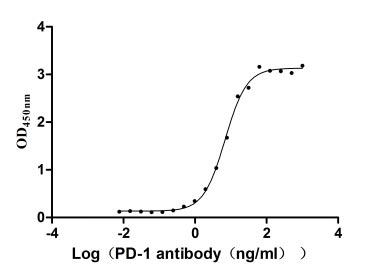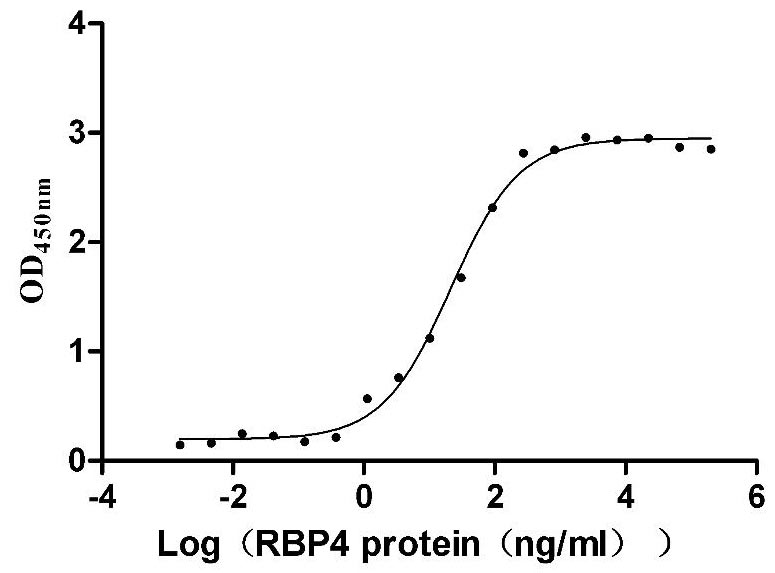Recombinant Mouse Bardet-Biedl syndrome 4 protein homolog (Bbs4)
-
货号:CSB-YP807457MO
-
规格:
-
来源:Yeast
-
其他:
-
货号:CSB-EP807457MO
-
规格:
-
来源:E.coli
-
其他:
-
货号:CSB-EP807457MO-B
-
规格:
-
来源:E.coli
-
共轭:Avi-tag Biotinylated
E. coli biotin ligase (BirA) is highly specific in covalently attaching biotin to the 15 amino acid AviTag peptide. This recombinant protein was biotinylated in vivo by AviTag-BirA technology, which method is BriA catalyzes amide linkage between the biotin and the specific lysine of the AviTag.
-
其他:
-
货号:CSB-BP807457MO
-
规格:
-
来源:Baculovirus
-
其他:
-
货号:CSB-MP807457MO
-
规格:
-
来源:Mammalian cell
-
其他:
产品详情
-
纯度:>85% (SDS-PAGE)
-
基因名:Bbs4
-
Uniprot No.:
-
别名:Bbs4Bardet-Biedl syndrome 4 protein homolog
-
种属:Mus musculus (Mouse)
-
蛋白长度:full length protein
-
表达区域:1-520
-
氨基酸序列MAEVKLGMKT QVPASVESQK PRSKKAPDFP IVEKQNWLIH LHYIRKDYEA CKAVIKEQLQ ETQGLCEYAI YVQALIFRLE GNIQESLELF QTCAVLSPQC ADNLKQVARS LFLLGKHKAA TEVYNEAAKL NQKDWEICHN LGVCYTYLKQ FNKAQDQLHS ALQLNKHDLT YIMLGKIHLL QGDLDKAIEI YKKAVEFSPE NTELLTTLGL LYLQLGVYQK AFEHLGNALT YDPANYKAIL AAGSMMQTHG DFDVALTKYR VVACAIPESP PLWNNIGMCF FGKKKYVAAI SCLKRANYLA PFDWKILYNL GLVHLTMQQY ASAFHFLSAA INFQPKMGEL YMLLAVALTN LEDIENARRA YVEAVRLDKC NPLVNLNYAV LLYNQGEKKS ALAQYQEMEK KVNFLKDNSP LEFDSEMVEM AQKLGAALQV GEALVWTKPV KDPKTKHRTN SGSKSATLQQ PLGSIQALGQ AMSSAAAYRK ILSGAVGAQL PKPPSLPLEP EPEPTVEASP TEASEQKKEK
-
蛋白标签:Tag type will be determined during the manufacturing process.
The tag type will be determined during production process. If you have specified tag type, please tell us and we will develop the specified tag preferentially. -
产品提供形式:Lyophilized powder
Note: We will preferentially ship the format that we have in stock, however, if you have any special requirement for the format, please remark your requirement when placing the order, we will prepare according to your demand. -
复溶:We recommend that this vial be briefly centrifuged prior to opening to bring the contents to the bottom. Please reconstitute protein in deionized sterile water to a concentration of 0.1-1.0 mg/mL.We recommend to add 5-50% of glycerol (final concentration) and aliquot for long-term storage at -20℃/-80℃. Our default final concentration of glycerol is 50%. Customers could use it as reference.
-
储存条件:Store at -20°C/-80°C upon receipt, aliquoting is necessary for mutiple use. Avoid repeated freeze-thaw cycles.
-
保质期:The shelf life is related to many factors, storage state, buffer ingredients, storage temperature and the stability of the protein itself.
Generally, the shelf life of liquid form is 6 months at -20°C/-80°C. The shelf life of lyophilized form is 12 months at -20°C/-80°C. -
货期:Delivery time may differ from different purchasing way or location, please kindly consult your local distributors for specific delivery time.Note: All of our proteins are default shipped with normal blue ice packs, if you request to ship with dry ice, please communicate with us in advance and extra fees will be charged.
-
注意事项:Repeated freezing and thawing is not recommended. Store working aliquots at 4°C for up to one week.
-
Datasheet :Please contact us to get it.
靶点详情
-
功能:The BBSome complex is thought to function as a coat complex required for sorting of specific membrane proteins to the primary cilia. The BBSome complex is required for ciliogenesis but is dispensable for centriolar satellite function. This ciliogenic function is mediated in part by the Rab8 GDP/GTP exchange factor, which localizes to the basal body and contacts the BBSome. Rab8(GTP) enters the primary cilium and promotes extension of the ciliary membrane. Firstly the BBSome associates with the ciliary membrane and binds to RAB3IP/Rabin8, the guanosyl exchange factor (GEF) for Rab8 and then the Rab8-GTP localizes to the cilium and promotes docking and fusion of carrier vesicles to the base of the ciliary membrane. The BBSome complex, together with the LTZL1, controls SMO ciliary trafficking and contributes to the sonic hedgehog (SHH) pathway regulation. Required for proper BBSome complex assembly and its ciliary localization. Required for microtubule anchoring at the centrosome but not for microtubule nucleation. May be required for the dynein-mediated transport of pericentriolar proteins to the centrosome.
-
基因功能参考文献:
- Insulin regulates Bbs4 expression during adipogenesis. PMID: 28371235
- demonstrated that the MKS transition zone complex cooperates with the BBSome to mediate trafficking of specific trans-membrane receptors to the cilium PMID: 28291807
- Bbs1, Bbs2, and Bbs4 proteins (BBSome) are bona fide constituents of intraflagellar transport in olfactory sensory neurons. PMID: 25504142
- Bbs4 silencing in 3T3F442A preadipocytes induced accelerated cell division and aberrant differentiation. Bbs4 silenced cells accumulate significantly more triglycerides than control adipocytes. PMID: 24500759
- The BBSome binds to the N-terminal region of CEP290 through BBS4 and co-localizes with CEP290 to the transition zone (TZ) of primary cilia and centriolar satellites in ciliated cells, as well as to the connecting cilium in photoreceptor cells. PMID: 23943788
- loss of BBS1, BBS4, or OFD1 led to decreased NF-kappaB activity and concomitant IkappaBbeta accumulation and that these defects were ameliorated with SFN treatment. PMID: 24691443
- Bbs4-null mice develop both motile and primary cilia, demonstrating that Bbs4 is not required for global cilia formation. PMID: 15173597
- deletions of Bbs1 or Bbs4 affected the olfactory epithelium, causing severe reduction of the ciliated border, disorganization of the dendritic microtubule network and trapping of olfactory ciliary proteins in dendrites and cell bodies. PMID: 15322545
- Evaluations of mice null for Bbs4, have uncovered phenotypic features with age-dependent penetrance and variable expressivity, partially recapitulating the human Bardet-Biedl syndrome phenotype. PMID: 16794820
- Lacking Bbs4 does not lead to aberrant cilia or basal body structure. However, the dynamics of cilia assembly is altered in Bbs4(-/-) cells, suggesting a role for Bbs4 in the regulation of ciliary assembly. PMID: 17519557
- The specific loss of photoreceptors in Bbs4(-)(/)(-) mice allows us to identify a set of genes that are preferentially expressed in photoreceptors compared with other cell types found in the eye PMID: 17591906
- ablation of BBS1 and BBS4 leads to alterations of s.c. sensory innervation and trafficking of the thermosensory channel TRPV1 and the mechanosensory channel STOML3 PMID: 17959775
- Although BBS proteins were not required for ciliogenesis, their loss caused structural defects in a fraction of cilia covering mouse airway epithelia in Bbs1, Bbs2, Bbs4, and Bbs6 mutant mice. PMID: 18299575
- a lack of ciliary localization of somatostatin receptor type 3 (Sstr3) and melanin-concentrating hormone receptor 1 (Mchr1) in neurons from mice lacking the Bbs2 or Bbs4 gene PMID: 18334641
- Bardet-Biedl syndrome (BBS) proteins mediate LepR trafficking and that impaired LepR signaling underlies energy imbalance in BBS. PMID: 19150989
显示更多
收起更多
-
亚细胞定位:Cytoplasm, cytoskeleton, microtubule organizing center, centrosome. Cell projection, cilium membrane. Cytoplasm. Cytoplasm, cytoskeleton, microtubule organizing center, centrosome, centriolar satellite. Cell projection, cilium, flagellum. Cell projection, cilium. Note=Localizes to the pericentriolar material. Centrosomal localization requires dynein (By similarity). Localizes to the connecting cilium of photoreceptor cells (PubMed:23943788).
-
蛋白家族:BBS4 family
-
组织特异性:Expressed in the hippocampus and dentate gyrus, the columnar epithelial cells of bronchioles, the olfactory epithelium and the inner segment and outer nuclear layer of the retina. Expressed in testis.
-
数据库链接:
KEGG: mmu:102774
STRING: 10090.ENSMUSP00000026265
UniGene: Mm.200714
Most popular with customers
-
Recombinant Human Programmed cell death protein 1 (PDCD1), partial (Active)
Express system: Mammalian cell
Species: Homo sapiens (Human)
-
Recombinant Human Angiopoietin-2 (ANGPT2) (Active)
Express system: Mammalian cell
Species: Homo sapiens (Human)
-
Recombinant Mouse Transthyretin (Ttr) (Active)
Express system: Mammalian cell
Species: Mus musculus (Mouse)
-
Recombinant Human Claudin-6 (CLDN6)-VLPs (Active)
Express system: Mammalian cell
Species: Homo sapiens (Human)
-
Recombinant Human Microtubule-associated protein tau (MAPT) (Active)
Express system: Mammalian cell
Species: Homo sapiens (Human)
-
Recombinant Human Myosin regulatory light chain 12A (MYL12A) (Active)
Express system: E.coli
Species: Homo sapiens (Human)
-
Recombinant Macaca fascicularis C-type lectin domain family 4 member C(CLEC4C), partial (Active)
Express system: Mammalian cell
Species: Macaca fascicularis (Crab-eating macaque) (Cynomolgus monkey)



-AC1.jpg)

-AC1.jpg)
-AC1.jpg)












